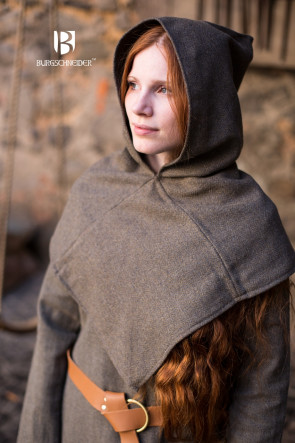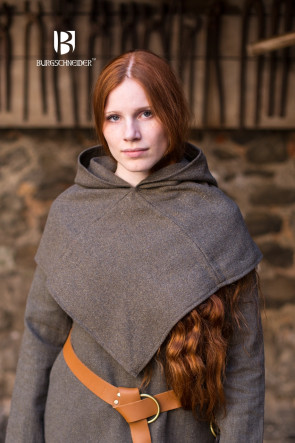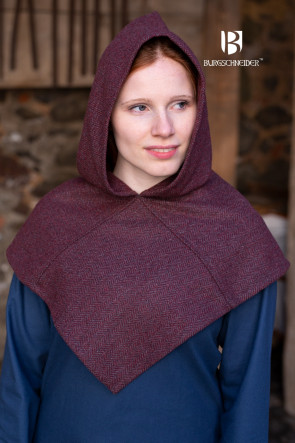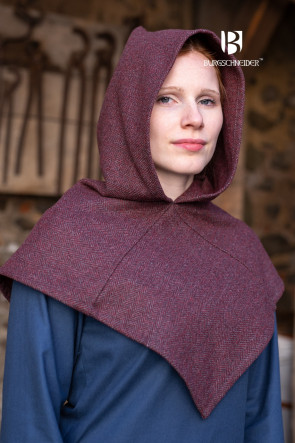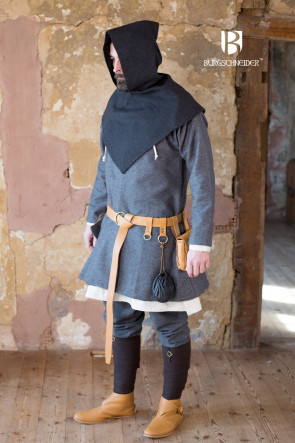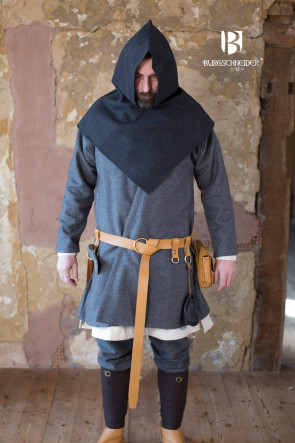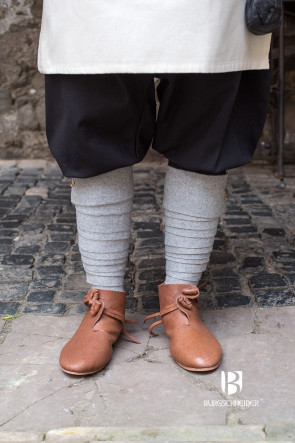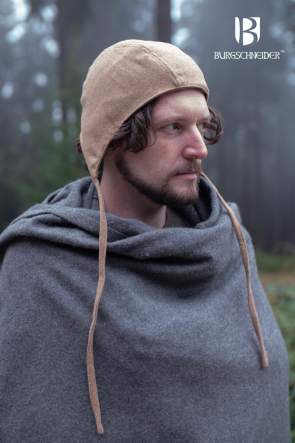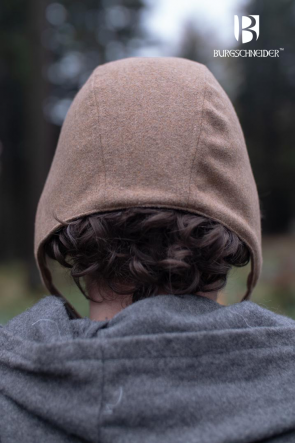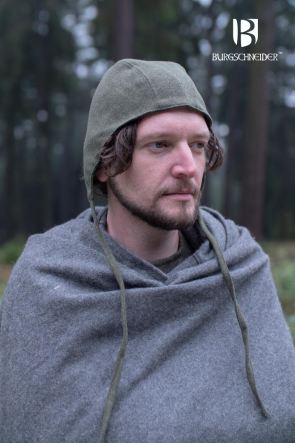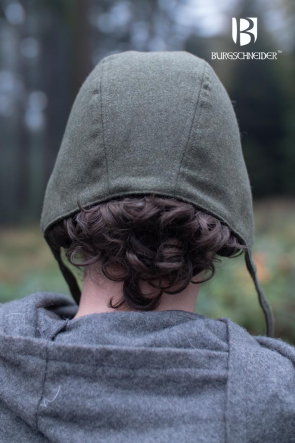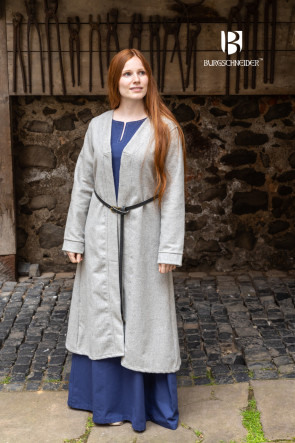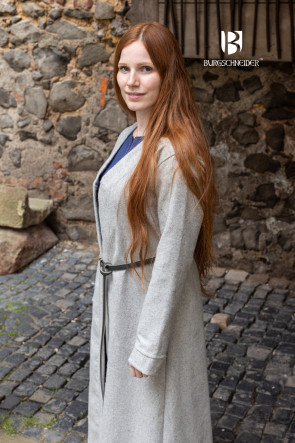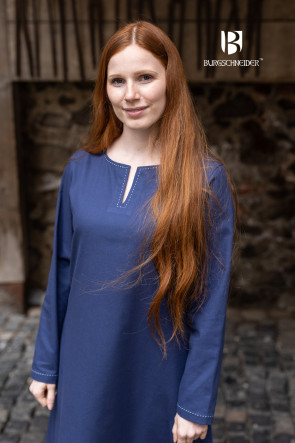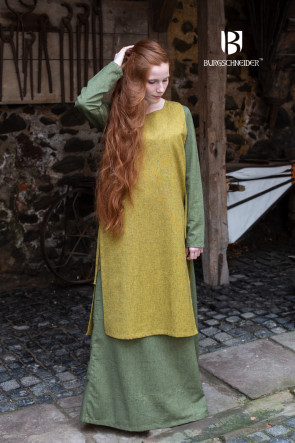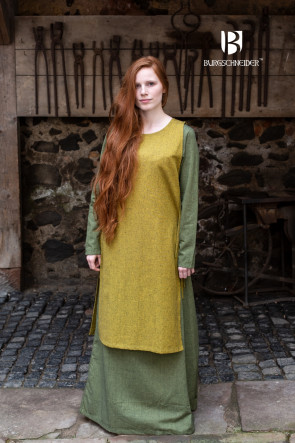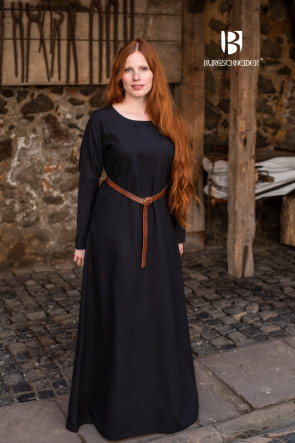Historical Clothing
Clothing in the Middle Ages from today’s perspective
The Middle Ages encompasses an enormous time span in the history of mankind—from the 6th to the 15th centuries. Even though there is an enormous difference in the way people dressed during the various eras of the Middle Ages, throughout all strata of the European population it was common to wear clothing in layers that were often divided into outer- and undergarments. Because clothes in the Middle Ages were often used to recognize the wearer’s station in life and had therefore a more symbolic function, sumptuary laws decided which stratum was allowed to wear—or prohibited from wearing—a given kind of clothing. Their main goal was to prevent the peasantry from dressing in the kind of clothes the nobles fancied.
Differences in clothing in the middle ages
Sometimes clothing in the Middle Ages varied, due to the sumptuary laws and financial considerations. Not only the wearer’s station in life played a role here, but also gender, region, and the given sub-epoch within the Middle Ages. The fashion among the nobles for instance changed rather rapidly throughout the era, whereas the peasantry’s clothing remained more or less the same, since they had fewer resources at their disposal than did the rich and their clothes didn’t need to be stylish but rather practical.
Women’s garments had to be longer than those of men, as it was unseemly for them to reveal too much of their figure or undergarments. Yet this attitude was gradually set aside over the course of time during the Middle Ages. Also, married women were expected to cover their hair, a rule, that, however, declined in importance by the end of the Middle Ages, and as a consequence, women started wearing elaborate hairstyles and headdresses.
Medieval clothing today
Today, many people harbor a biased, overly generalized view of the Middle Ages, often ignoring significant differences among epochs or regions. Views on medieval clothing are commonly derived from movies in which the actors’ outfits aren’t based on historical facts. Since a lot of false information and myths circulate about the Middle Ages, the costumes are frequently changed to fit the story of the movie or simply are not carefully enough researched. In historical movies, the costuming ends up representing a random mixture of different epochs and regions, or even contains fantasy elements, creating an appealing style—but an inaccurate one.
-
Skjoldehamn Gugel Knud Herringbone - Olive/Grey
The Skjoldehamn Cowl was discovered in a pagan grave from the first half of the 11th century. This is one of the first examples of the headgear "Gugel" itself.
Learn More
The hood has a basic square shape, characteristically the wide brim ends with a corner on the chest.
The grave find from Skjoldehamn raised many questions since its recovery in 1936 and still occupies today. According to current research, the dating of the pagan grave in the marshland is the first half of the 11th century. The hood of the gugel from Skjoldehamn has a simple square basic shape and a very wide brim which does not fall round but with a corner on the chest. This gugel is also a very early example of the type of headgear that became a ubiquitous garment in Europe during the Middle Ages.
In the course of research, attempts were made to assign the garment to a gender and cultural group. For this purpose, not only the DNA of the buried person was examined more closely but also the additional finds. The enclosed trousers determined the theory of the researchers that the person must have been male. DNA examination in 1999 showed no Y chromosome present in the bones which supported the theory that it had to be a woman instead. However, this methodology is considered outdated.
The question of culture points to Norway. This is assumed by ornamentation and morphological features which suggest that the buried person was a Sami tribal member. Further research is needed, as some key evidence for these hypotheses is still lacking. More modern DNA analysis and research into the history of the fashions of the various Sami groups will shed light on this.€34.90 -
Skjoldehamn Gugel Knud Herringbone - Burgundy/Grey
The Skjoldehamn Cowl was discovered in a pagan grave from the first half of the 11th century. This is one of the first examples of the headgear "Gugel" itself.
Learn More
The hood has a basic square shape, characteristically the wide brim ends with a corner on the chest.
The grave find from Skjoldehamn raised many questions since its recovery in 1936 and still occupies today. According to current research, the dating of the pagan grave in the marshland is the first half of the 11th century. The hood of the gugel from Skjoldehamn has a simple square basic shape and a very wide brim which does not fall round but with a corner on the chest. This gugel is also a very early example of the type of headgear that became a ubiquitous garment in Europe during the Middle Ages.
In the course of research, attempts were made to assign the garment to a gender and cultural group. For this purpose, not only the DNA of the buried person was examined more closely but also the additional finds. The enclosed trousers determined the theory of the researchers that the person must have been male. DNA examination in 1999 showed no Y chromosome present in the bones which supported the theory that it had to be a woman instead. However, this methodology is considered outdated.
The question of culture points to Norway. This is assumed by ornamentation and morphological features which suggest that the buried person was a Sami tribal member. Further research is needed, as some key evidence for these hypotheses is still lacking. More modern DNA analysis and research into the history of the fashions of the various Sami groups will shed light on this.€34.90 -
Skjoldehamn Gugel Knud Herringbone - Black/Grey
The Skjoldehamn Cowl was discovered in a pagan grave from the first half of the 11th century. This is one of the first examples of the headgear "Gugel" itself.
Learn More
The hood has a basic square shape, characteristically the wide brim ends with a corner on the chest.
The grave find from Skjoldehamn raised many questions since its recovery in 1936 and still occupies today. According to current research, the dating of the pagan grave in the marshland is the first half of the 11th century. The hood of the gugel from Skjoldehamn has a simple square basic shape and a very wide brim which does not fall round but with a corner on the chest. This gugel is also a very early example of the type of headgear that became a ubiquitous garment in Europe during the Middle Ages.
In the course of research, attempts were made to assign the garment to a gender and cultural group. For this purpose, not only the DNA of the buried person was examined more closely but also the additional finds. The enclosed trousers determined the theory of the researchers that the person must have been male. DNA examination in 1999 showed no Y chromosome present in the bones which supported the theory that it had to be a woman instead. However, this methodology is considered outdated.
The question of culture points to Norway. This is assumed by ornamentation and morphological features which suggest that the buried person was a Sami tribal member. Further research is needed, as some key evidence for these hypotheses is still lacking. More modern DNA analysis and research into the history of the fashions of the various Sami groups will shed light on this.€34.90 -
Wool Winingas Aki - Grey
Winingas have been worn since the Iron Age. The Romans at Hadrian's Wall used them, as did the Germanic tribes, Byzantines, Franks, Alamanni, Bavarians, Wends (Slavs), and later in the Middle Ages, the Normans and Vikings. Winingas were widespread throughout Central and Northern Europe.
Learn More
In the beginning, winingas served as a substitute for socks. From foot to lower leg, they are wrapped over the pants to below the knee and fixed with a fibula to protect and keep the wearer warm.
On the basis of textile finds in Damendorf, Oberaltendorf, Bernuthsfeld and the Thorsberg moor, there’s proof these have been worn from the 2nd to the 8th century, and also on the carpet of Bayeux from the year 1066, winingas are shown.
Our Wool Winingas Aki stay in this tradition and are made of wool with the dimensions 380cm x 10cm. Of course, we supply two winingas, you do not buy socks individually.€19.90 -
€29.90
-
€29.90
-
Birka Coat Aslaug - Wool Grey
- Material: Herringbone Wool Blend
- Genre: Historic
- Sizes: S - XXXL
- Reference: Birka Coat
€79.90 -
Underdress Feme - Dark Blue
- Material: 100% Cotton
- Genre: Historic
- Sizes: X - XXXL
- Reference: Haithabu Serk
€49.90 -
Outer Garment Haithabu - Saffron Yellow
Outer Garment Haithabu by Burgschneider
Cotton
The Haithabu overdress is part of a simple women's clothing in Viking tradition. Lacing on both sides for better wearing comfort. The material used is made of a robust, coarse woven fabric which is made of 100% uncombed cotton.
- Material: 100% Cotton
- Genre: Historic
- Sizes: S - XXL
- Reference: Hedeby Dress
€29.90 -
Underdress Freya - Black
- Material: 100% Cotton
- Genre: Historic
- Sizes: S - XXXL
- Reference: Haithabu Serk
€49.90







